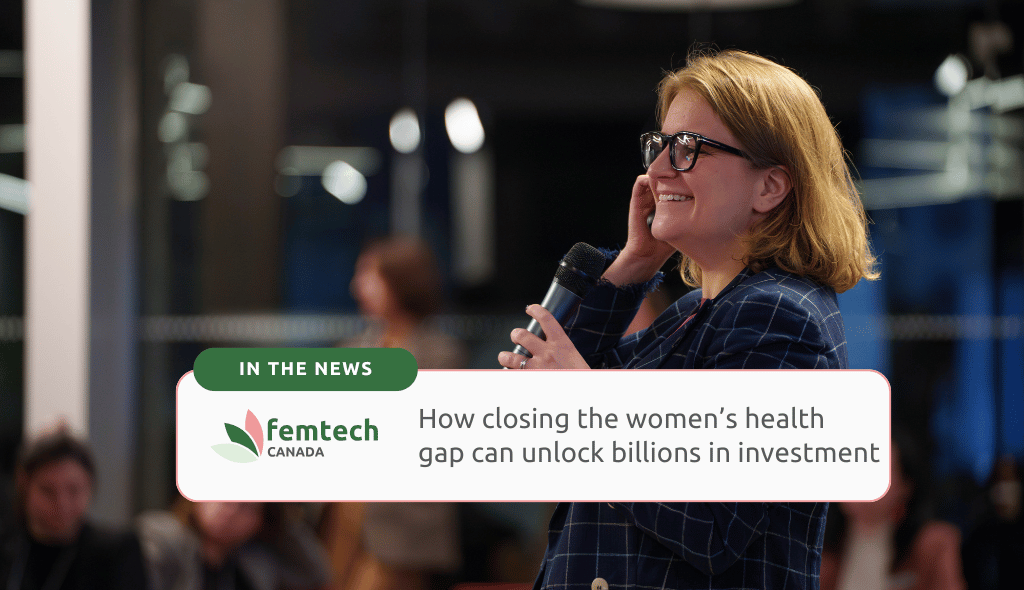A conversation with Liza Vityuk, McKinsey & Company at the Femtech Canada Forum in Montreal
Women’s health has been overlooked for far too long, leaving millions without the care and attention they deserve. But change is coming. New research is showing just how deep the gender health gap runs—and how much potential there is for investment and innovation to turn things around.
Liza Vityuk, Partner at McKinsey & Company, a strategic management consulting firm, recently shared key insights from McKinsey’s research on the gender health gap, breaking down common myths, highlighting urgent challenges, and outlining a path forward for better healthcare and economic growth at the Femtech Canada Forum in Montreal, Quebec.
For a full breakdown, watch the video or read the key takeaways below.
Why the gender health gap matters
For decades, women’s health has been treated as a niche issue, but the reality is far from that. Despite making up 50.4% of Canada’s population, women experience significant disparities in health outcomes, care, and investment.
“We found that many of the assumptions about women’s health simply don’t hold up to the data,” said Vityuk. “By debunking these myths, we can shift the conversation and focus on real solutions.”
- Myth #1: Women live longer, so they must be healthier. False. Women actually spend 25% more time in poor health.
- Myth #2: The health gap only affects older women. False. Nearly two-thirds of women’s health burdens occur between the ages of 20 and 70—critical career and family-building years.
- Myth #3: Women’s health is just about reproductive issues. False. Only 5% of the health gap relates to reproductive health. The majority of conditions affect women disproportionately, such as autoimmune diseases (80% of cases are in women) and cardiovascular disease (women are 7x more likely to be discharged after a heart attack due to misdiagnosis).
- Myth #4: Women’s health is a niche market. False. A $1 trillion opportunity exists in closing the health gap, with Canada alone standing to gain $27 billion in GDP growth.
The data gap: a systemic problem
“One of the biggest barriers to progress is the lack of data on women’s health,” said Vityuk. “For too long, research and medical education have treated women as ‘small men,’ leading to misdiagnosis and ineffective treatments. This must change.”
- Only 50% of medical treatments include sex-disaggregated data.
- 66% of treatments that do analyze sex differences show that women are disadvantaged.
- Women are more likely to be prescribed antidepressants instead of proper medical treatment for physical health issues.
- Endometriosis affects 1 in 10 women, yet it takes 7-10 years to receive a diagnosis in Canada, and only 20 drugs are in development globally for the condition—compared to hundreds for diseases like diabetes.
“This is not the state of the world we want to pass on to the next generation,” added Vityuk. “For a science-based field like medicine, we’re still operating on a lot of myths.”
Investment in women’s health: a missed opportunity
Only 1% of global healthcare investment is directed toward women-specific conditions. Canada does slightly better at 4%, but this is still far from enough to meet demand.
Underfunded conditions:
- Autoimmune diseases: 80% of cases affect women, yet only 7% of research funding focuses on women.
- Cardiovascular disease: Women are more likely to die after a heart attack, yet only 5% of research funding is directed at understanding sex-based differences.
- Alzheimer’s disease: Women account for two-thirds of cases, yet research remains disproportionately focused on men.
Menopause: Only 20% of women receive a diagnosis, despite universal prevalence.
A path forward: what needs to change
To close the gender health gap, action is needed on multiple fronts:
- Better data collection and research
- Ensure clinical trials analyze sex differences.
- Increase research funding for women’s health beyond reproduction.
- Improved access to care
- Address systemic bias in diagnosis and treatment.
- Ensure women receive proper pain management and care.
- Greater investment in women’s health
- Encourage venture capital and public funding in femtech.
- Support companies tackling chronic conditions that disproportionately affect women.
- Policy and workplace change
- Implement workplace policies for menopause, maternal health, and chronic disease support.
- Advocate for government funding and national strategies for women’s health.
Canada’s opportunity to lead
Several countries are already making progress:
- France recently invested €500 million in women’s health initiatives.
- The UK is pioneering workplace policies for menopause.
- Private sector investment in the US is growing rapidly.
Canada has the opportunity to be a global leader in this space. With a $27 billion GDP opportunity at stake, now is the time to act.
“This is a once-in-a-generation opportunity to redefine healthcare,” emphasized Vityuk. “It’s time to move from awareness to action.”
Watch the full session to hear more from Liza Vityuk and learn how business leaders, investors, and healthcare professionals can drive meaningful change.
This presentation was based on the 2024 McKinsey report which outlines the $1 trillion opportunity to close the women’s health gap by addressing unmet healthcare needs, improving health outcomes, and driving economic growth globally. Read the 2024 report here.
Since the recording, the McKinsey Health Institutes’ 2025 report was published and outlines a blueprint to close the women’s health gap, emphasizing targeted action across data collection, research, equitable care, and investment to improve women’s health outcomes globally and unlock $1 trillion in annual GDP by 2040. Read the 2025 report here.
Looking to get your Femtech company connected with resources and support?
Contact us today!

